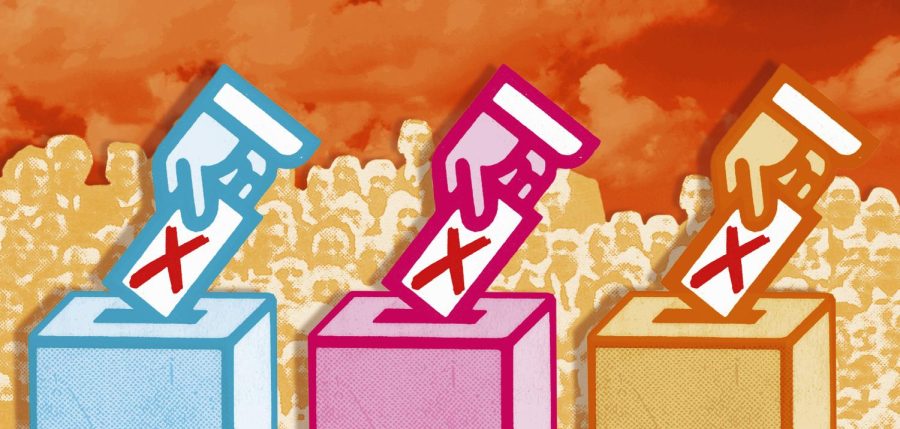Increasing young voter turnout in Ohio
October 6, 2020
With the voter registration deadline in Ohio today and the general election less than a month away, the task to increase turnout among the youth intensifies.
During the 2018 midterm elections, national voter turnout among 18 to 29-year-olds increased from 20% in 2014 to 36%. Despite the jump, the youth vote still remains a focal point for activists and officials.
Executive Director of the League of Women Voters of Ohio, Jen Miller, noted that there is still work to be done when it comes to encouraging students to vote.
“In 2018, we did a focus group with voters under the age of 25. It didn’t matter their education level, their socioeconomic status, those voters, those young adults who were active regular voters were ones who had someone helping them through the process,” Miller said. “So, if someone wasn’t voting, they would usually cite confusion.”
In 2014, there were 19,556 students enrolled at Kent State within the 18-21 age range. Only 2,703 voted. In 2018, there were 19,906 students enrolled at Kent State within the 18-21 age range. 6,569 voted. Data provided by the National Study of Learning, Voting and Engagement.
The confusion with the voting process ranged from not knowing how to register to not having the right ID according to Miller. What the focus group made Miller realize was that students needed more support to understand the election process and its importance.
The League of Women Voters of Ohio teamed up with high school teachers, college professors and technology experts to develop an online curriculum to educate students.
Topics in the curriculum include executive state government departments, local government, financing state government and elections and political parties among other topics. The online program has been distributed to schools across the state.
Accompanying the online tools is a podcast challenge in which students are asked to create a podcast no more than 5 minutes which explores a government related topic.
“This is brand new, and it’s in partnership with iHeartRadio,” Miller said. “The top 10 will be aired through iHeartRadio and the top three willl get cash prizes. So we certainly do hope that the Ohio youth will make podcasts about civics and voting and share those with friends and really start to create more conversation about why it’s so important that young people participate in government affairs and voting.”
For students living on campus, registering to vote and voting can become more difficult said Deputy Director of the Portage County Board of Elections, Terrie Nielsen. The most common mistake students make is using their mailing address when registering to vote instead of their physical address.
“Let’s take Centennial [Court] A for example. The GPS or physical location address is 275 Midway Drive. But the mailing address is 225 Midway Drive,” Nielsen said. “And what our students customarily do is they’ll put down 225 Midway Drive. The problem with that is there are 10 dorms that all use the same mailing address. Those dorms may not be in the same precinct.”
Students on campus are encouraged to include their physical address and the name of their dorm when registering to vote in Portage County. Nielsen said the extra step ensures they’re registering correctly and because the board of elections office has a list of all physical addresses, it makes the verification easier.
For in-person voting, students can use their driver’s license or a utility bill or paycheck which displays their address. For students with out of state licenses, Nielsen said the university can email them a zero balance utility bill which can be printed off and used as identification.
For absentee mail-in voting, the procedure is similar.
“If you’re doing an absentee by mail, there’s an ID envelope that you’re completing and returning. So, the ballot goes in the ID envelope and you’re completing the ID envelope,” Nielsen said. “We’ll ask you for your date of birth, one form of identification. It could be the last four of your social, your driver’s license number, or one of the other forms that we talked about like a utility bill, and your signature.”
The Portage County Board of Elections will double check all mail-in submissions to confirm the information matches the information in their voter registration database.
Both Nielsen and Miller said young voters should keep in mind to vote down the ballot. Miller specifically pointed out the necessity to conduct research on candidates and to use the information gathered to develop an election plan.
“I want them to do their research on candidates. They can do that at VOTE411.org. They can go to the candidate’s website. They can go to OpenSecrets.org, which will help them know who funds their campaigns,” Miller said. “I want them to do the research and think about what matters most to them. Is it climate change? Is it healthcare? Is it funding for education? Is it racial profiling?”
The youth vote is higher during presidential election years according to Nielsen who feels as though young voters should be consistently active. With so much attention on federal elections, Nielsen said students may neglect other important races.
“Right now there are two county commissioners that are up for reelection,” Nielsen said. “There’s a couple of judicial races. Those are really important.”
These local elected officials are people who are directly involved in the lives of voters within the county, said Nielsen. Furthermore, voters need to consider local ballot initiatives such as the fire department levy renewal in Kent.
Ultimately, it is in these local elections in which voters and their voices matter a great deal.
“We have had probably four races, whether it was a race for a candidate or an issue, that were decided by two or three votes,” Nielsen said. “So especially on a local level, every vote does count and can make a difference.”
Contact Chris Ramos at [email protected].









